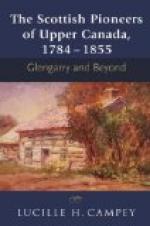Bison could now be seen in abundance. Kellsey was already acquainted with the musk ox, which he had seen in the colder regions near to Hudson Bay; but the bison seemed to him quite different, with horns growing like those of an English ox, black and short. In the middle of September he reached the country of the Newatamipoets, and presented to their chief, on behalf of the Hudson’s Bay Company, a present of clothes, knives, awls, tobacco, and a gun, gunpowder, and shot. On this journey Kellsey encountered the grizzly bear, a more common denizen of the western regions of North America. According to his own account, he and one of the Indians with him were attacked by two grizzly bears and obliged to climb into the branches of trees. The bears followed them; but Kellsey fired and killed one, and later on the other also. For this feat he was greatly reverenced by the Indians, and received the name of Mistopashish, or “little giant”. Kellsey afterwards rose to be governor of York Fort, on the west coast of Hudson Bay.
The next great explorer ranging westward from Hudson Bay was Anthony Hendry.[2] Anthony Hendry left York factory in 1754, with a company of Kri Indians, to make a great journey of exploration to the west, and with the deliberate intention of wintering with the natives and not returning for that purpose to Hudson Bay. By means of canoe travel and portages he reached Oxford Lake. From here he gained Moose Lake, and soon afterwards “the broad waters of the Saskatchewan—the first Englishman to see this great river of the western plains".[3] Twenty-two miles upstream from the point where it reached the Saskatchewan he came to a French fort which had only been standing for a year, and which represented probably the farthest advance northwards of the French Canadians.
[Footnote 2: The young or old reader of this and other books dealing with the exploration of the Canadian Dominion will be indeed puzzled between the various Hendrys and Henrys. The last-named was a prolific stock, from which several notable explorers and servants of the fur-trading companies were drawn. In this book a careful distinction must be made between the Anthony Hendrey or Hendey, who commenced his exploration of the west in 1754; the unrelated Alexander Henry the Elder, who journeyed between 1761 and 1776; and the nephew of the last-named, Alexander Henry the Younger, whose pioneering explorations occurred between 1799 and 1814.]




